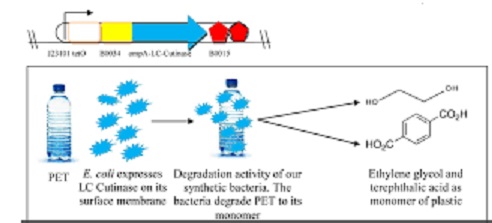Abstract
Yoshida et al. (Report, 11 March 2016, p. 1196) reported that the bacterium Ideonella sakaiensis 201-F6 can degrade and assimilate poly(ethylene terephthalate) (PET). However, the authors exaggerated degradation efficiency using a low-crystallinity PET and presented no straightforward experiments to verify depolymerization and assimilation of PET. Thus, the authors’ conclusions are rather misleading.bacterium degrades PET
Yoshida et al. (1) reported that they found a novel poly(ethylene terephthalate) (PET)–degrading bacterium, Ideonella sakaiensis 201-F6. The authors claim that there are very few reports on the biological degradation of PET, except that a few fungal species or enzymes have been shown to be able to degrade PET (1). However, the authors did not cite three previous studies demonstrating that some bacteria or bacterial enzymes, such as cutinases, are also able to effectively degrade PET (2–4).
The authors used a low-crystallinity PET (1.9%) as a tested substrate to dramatically boost the degradation efficiency of PET by I. sakaiensis 201-F6. Because PET is a semicrystalline polyester, only the amorphous regions were demonstrated to be susceptible to enzymatic degradation rather than crystalline regions (4, 5). Therefore, decreasing the crystallinity may substantially increase the degradability of PET. An earlier paper published by Vertommen et al. (5) indicates that the degradative activity of PET hydrolases (cutinase), from Fusarium solanipisi, for low-crystallinity PET (4.1%) is about 15 times as high as that of mid-crystallinity PET (13.7%) and 500 times as high as that of high-crystallinity PET (48.2%). Experimental data presented in the article by Yoshida et al. [figures 2D and 2E in (1)] also showed that the activity of PET hydrolases, from I. sakaiensis 201-F6, for low-crystallinity PET (1.9%) is about 20 times as high as that of commercial bottle-derived high-crystallinity PET (crystallinity was not specified in the article but often ranges from 30 to 40%). One might expect that if the commercial bottle-derived high-crystallinity PET was used as the tested substrate, then the degradation efficiency by I. sakaiensis 201-F6 would be very limited.bacterium degrades PET
The information about the changes in molecular weight of PET film after cultivation with I. sakaiensis 201-F6 was not presented, although it is well known that the decrease in molecular weight is a major indication of depolymerization and degradation of polymers (6–11). In our earlier work, we reported that polyethylene (PE) and polystyrene (PS) could be degraded by plastic-eating insects or their associated gut bacteria and presented the evidence of decrease in molecular weight of PE or PS after degradation (6–9). Yoshida et al. did use gel permeation chromatography to analyze the molecular weight of PET film before and after cultivation with consortium no. 46 [figure S1C in (1)]; however, no changes have been observed. One may speculate whether the surface degradation of PET film resulted only from the mechanical destruction by the bacterial consortium without any cleavage of the long-chain molecules. Nevertheless, evidence for the degradation of PET by I. sakaiensis 201-F6 could have been more complete if data of molecular weight changes had been presented.bacterium degrades PET
The assimilation of PET by I. sakaiensis 201-F6 as a carbon source for growth does not appear to be sufficiently supported by the data despite the adherence of I. sakaiensis 201-F6 to PET film, as shown in the presented scanning electronic micrograph images [figures 2, D and 2E in (1)]. Carbon isotopic tracer experiments can verify assimilation of organic carbon in the biomass [e.g, (7)] but were not performed. The authors also could have easily measured changes in the number or the weight of I. sakaiensis 201-F6 cells grown in a medium with PET as a sole carbon source. Without such data, the authors’ claim that the bacterium can assimilate PET is unconvincing.

 Key Laboratory of Bio-Inspired Smart Interfacial Science and Technology of Ministry of Education, School of Chemistry and Environment, Beihang University, Beijing 100191, P.R. China.
Key Laboratory of Bio-Inspired Smart Interfacial Science and Technology of Ministry of Education, School of Chemistry and Environment, Beihang University, Beijing 100191, P.R. China.